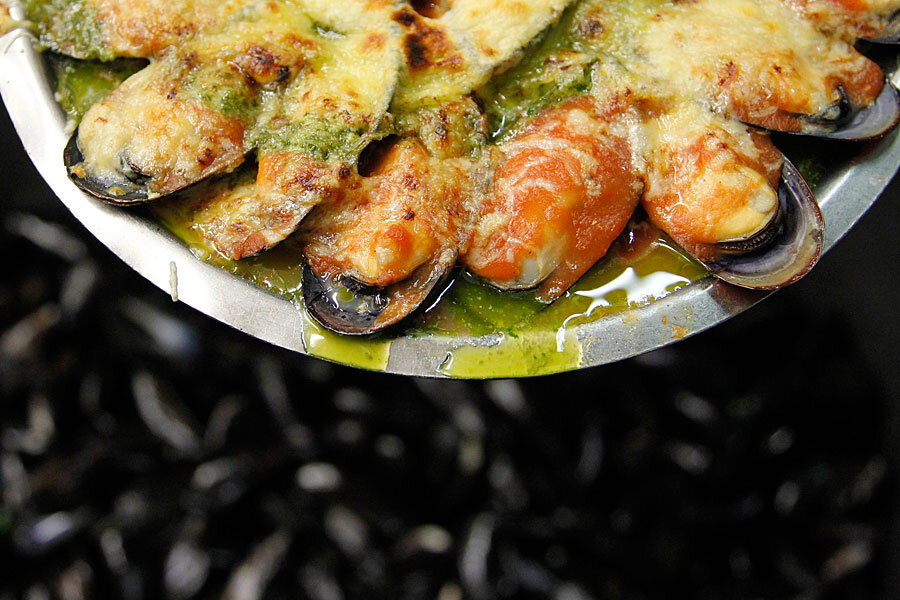How algae blooms could take mussels off the menu
Loading...
In Mangalore, mollusks may soon be marred by warmer temperatures.
An interdisciplinary study found that poisonous algal blooms, accommodated by climate change, could stunt a growing mollusk-farming industry. Lucy Turner, a zoophysiologist at the University of Gothenburg in Sweden, presented the findings to the Society for Experimental Biology on Friday.
In southwest India, mussels are typically caught by hand on a small scale. The industry is more developed in other regions, but still not quite at the level of shrimp and prawn farming operations. So why is the humble mussel such a big concern?
“There are moves to try and grow this industry on a country-wide scale,” Dr. Turner says, “especially because of the economic and population growth that has taken place in India in recent decades.”
And according to Turner, climate change could dole out serious damage to the budding industry.
Increased rainfall, a symptom of global warming, can dilute the salt content of coastal waters. Environments with decreased salinity and increased warmth are ideal for dense aggregations of algae and plankton called Harmful Algal Blooms. As filter feeders, mussels may consume these microorganisms, many of which produce harmful neurotoxins.
These toxins are not usually fatal to mussel species. But humans do not have the same immunity; eating a mussel with traces of these chemicals can pose health risks, say scientists. Red tide algae blooms, for example, produce large amounts of saxitoxin – a neurotoxin said to cause paralytic shellfish poisoning in humans and other animals.
In a controlled experiment, Turner and colleagues exposed mussels to high temperatures and low salinity. They found that these conditions put significant stress on the mussels, compromising their immune systems.
And while the mussels aren’t in mortal peril, their overall health is important to coastal ecosystems. Mussels are filter feeders, taking in food particles from the water and depositing nutritious waste for invertebrate bottom feeders. Their hard bodies also provide additional surface area for smaller creatures who might grow around or in between them.
There are currently no long-term datasets for the seasonal presence of toxic blooms in India, Turner says. By acquiring this data, she and her colleagues could make predictions about when to avoid bivalve harvests. Turner hopes this work will spur government-lead monitoring of coastal water quality. In the meantime, they plan to conduct similar studies on oysters and clams, while a sister study will direct its attention to prawn farms.
“As ever with any kind of monitoring scheme there has to be the money and will in place to make sure it continues to run,” Turner says. “In a country such as India these will likely be the main challenges.”
Vera Trainer, an expert in marine biotoxins at NOAA Fisheries, agrees that monitoring is a necessary step. Dr. Trainer is based on the West Coast, where shellfishing fulfills commercial, subsistence, and recreational purposes. There, an increasing number of harmful blooms has resulted in beach-wide shellfishing bans. The bans have been especially hard on Pacific tribal communities who have eaten mollusks such as mussels and razor clams for thousands of years.
“It’s tribal members that don’t have corner grocery stores that have good food,” Trainer says. “So it’s eating fried chicken or eating good protein. And right now, it’s fried chicken.”
PSP-contamination fears have also prompted large seafood recalls along coastal Washington. Individual fisheries can face financial loss in the millions as a result of beach closures. In this way, Puget Sound can be a window into the future of India’s shellfishing economy.
But unlike India, Pacific US fisheries have already implemented algal monitoring. Local health departments used to implement sweeping bans, but researchers can now pinpoint the most problematic sources of harmful blooms, allowing safe areas to remain open to mollusk harvests. Other research has suggested the seabed dredging efforts have caused algal flares.
Meanwhile, NOAA’s Prevention, Control, and Mitigation of Harmful Algal Blooms (PCMHAB) program is aimed at more long-term solutions. In Puget Sound, some seagrass beds have been stripped away as a byproduct of coastal development. In those areas, harmful blooms appear to be more severe. Most recently, Noboharu Inaba and colleagues proposed that native seagrasses could control and kill toxic algae.
“If the seagrass are endemic to the area, and they’ve been removed for one reason or another, I think replanting could be something that’s environmentally favorable,” Trainer says.
Other proposed solutions include the introduction of barley grass and clay into coastal waters. But these fixes, even if they do work, are a long way from being implemented.
“There are alternatives,” Trainer says. “It’s definitely tricky because there are environmental concerns, and it has to be proven that these potential tools aren’t going to make things worse.”






